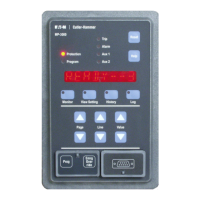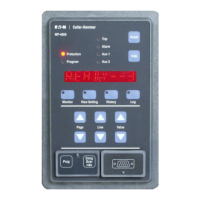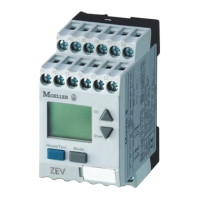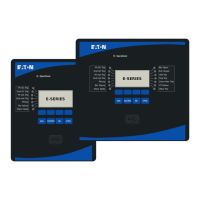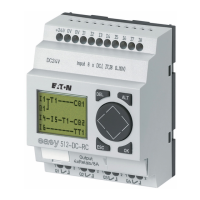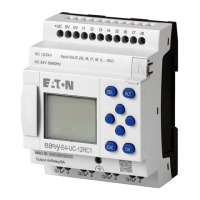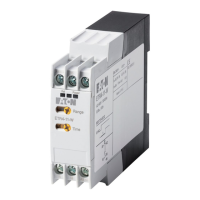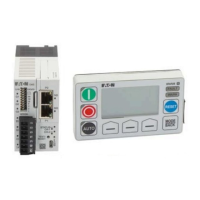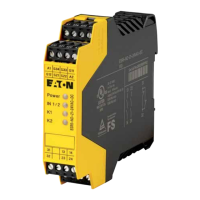Page 5-6
Effective 10/02For more information visit: www.cutler-hammer.eaton.comIL17562BH04
5.4 Page 4, SP ALARM, Settings P4L1 to P4L8
This page contains the settings needed to configure the alarm
functions. Each alarm function can be disabled.
NOTE
EVEN IF AN ALARM FUNCTION IS ENABLED ON THIS PAGE, IT
MUST ALSO BE DIRECTED TO AN OUTPUT RELAY TO PRODUCE
CONTACT OPERATION FOR REMOTE OR ANNUNCIATOR
ALARMING. NORMALLY (AND BY FACTORY DEFAULT SETTINGS),
THE CONDITIONS SHOULD ALL BE DIRECTED TO THE ALARM
RELAY BY THE 22 SETTINGS ON PROGRAM MODE PAGE 8.
THEY MAY ALSO BE SELECTIVELY DIRECTED TO THE AUX 1
AND/OR AUX 2 OUTPUT RELAYS USING THE SETTINGS ON
PROGRAM MODE PAGES 9 AND 10 RESPECTIVELY.
If you configure an alarm here, but don’t set it to activate any output
relay on Pages 8 to 10, alarm conditions will still appear in all displays
and logs, and in communications information sent to a PowerNet host.
5.4.1 Setting P4L1, Ground Fault Alarm Level (GFA)
Sets the ground fault alarm current pickup level in percent of ground
Ct ratio numerator. For example, with a 50:5 ground fault Ct and a
setting of 10%, the GFA function will pick up at 10% of 50A, or 5A
actual ground fault current in the motor. The start and/or run delays
must expire before the alarm output occurs.
5.4.2 Setting P4L2,
I2T Alarm Level (I2TA)
Sets the
I2T model thermal accumulator or bucket level at which the
relay will alarm, in percent of
I2T bucket trip value. This important
alarm indicates that the MP-3000 thermal model is progressing toward
a thermal protective trip (thermal capacity bucket is filling), so that the
user can act to reduce loading or protect the process.
This setting also determines when the
I2T trip condition can reset.
After a trip, the
I2T bucket or thermal accumulator must cool below
the
I2T alarm level before the thermal trip can reset. See setting P12L5
for more on resetting of thermal trip.
5.4.3 Setting P4L3, Jam Alarm Level (JMA)
Sets the current limit in percent of FLA at which the jam alarm picks
up. This alarm can be set to OFF. Set to a lower level than the jam trip
level P3L6. The start delay is the same as for the jam trip function; see
P3L7. Use with run delay, next.
5.4.4 Setting P4L4, Jam Alarm Run Delay (JMAR)
Sets the number of seconds that the jam alarm level must be
maintained before the alarm occurs.
5.4.5 Setting P4L5, Underload Alarm Level (ULA)
Specifies the current level in percent of FLA below which the MP-3000
alarms. The start delay is the same as for underload trip; see P3L10.
Use with the underload run delay, next. Note: ULA must be set to a
higher current value than the underload trip level P3L9.
5.4.6 Setting P4L6, Underload Alarm Run Delay (ULAR)
Sets the number of seconds that the current must remain below the
underload alarm limit before the alarm occurs.
5.4.7 Setting P4L7, Phase Unbalance Alarm Level (UBA)
Sets the percent of phase current unbalance above which the MP-
3000 alarms. This alarm can be set to OFF. The start delay is the same
as for the phase unbalance trip; see P3L13. Use with unbalance alarm
run delay, next. See P3L12 above, unbalance trip level, for more
information.
5.4.8 Setting P4L8, Phase Unbalance Alarm Run Delay (UBAR)
Sets the number of seconds that a phase unbalance alarm must be
maintained before the alarm occurs.
5.5 Page 5, SP START, Settings P5L1 to P5L12
This page contains settings that control motor starting and jogging
functions.
5.5.1 Setting P5L1, Starts Per Time Allowed (ST/T)
Sets the maximum number of motor starts permitted within the time
set in P5L2, next. To disable this function, set P5L2 to OFF.
The record of recent start times is kept in a memory stack; the oldest
starts in the memory are deleted as they age beyond the time limit set
below in P5L2. If the maximum number of starts is reached within the
set time window, the relay raises an alarm with STEX A on the display.
To observe the per time limiting values, check the remaining starts
RMST and time until start TUS displays on the monitor page.
After the motor stops, the relay trips with the message STEX XXX
where XXX is the number of minutes before the oldest start is deleted
from the memory stack, allowing the motor to start. XXX can be
observed to count down as the motor sits idle.
5.5.2 Setting P5L2, Time Allowed For Starts Count (T/ST)
Sets the number of minutes within which the maximum number of
starts cannot be exceeded. This function can be set to OFF.
5.5.3 Setting P5L3, Time Between Starts (TBS)
Sets the time in minutes that must expire from one start until the next
is permitted. This function can be set to OFF.
5.5.4 Setting P5L4, Number of Cold Starts Allowed (NOCS)
Sets the number of cold starts allowed from 1 to 5. Most motors can
tolerate some number of consecutive cold starts before the time
between starts is enforced. The MP-3000 treats a start as the first in a
sequence of cold starts if the motor has been stopped for at least the
time period which is the greatest of:
• Setting P5L2, Time Allowed For Starts Count (T/ST).
• Setting P5L3, Time Between Starts (TBS)
• One hour.
Subsequent starts are treated as additional cold starts in the same
sequence only if they follow the previous start by ten minutes or less,
until the set number of cold starts is reached. Starts after this are
subject to time and count limits imposed by settings P5L1 through
P5L3 above.
5.5.5 Setting P5L5, Motor Start Transition Current Level (TRNC)
Sets the current level defining the transition from the START to the
RUN state. This setting, along with settings P5L6 and P5L7, determine
when the MP-3000 declares a transition from START to RUN.
The TRNC setting must be greater than the Stop Current Threshold
